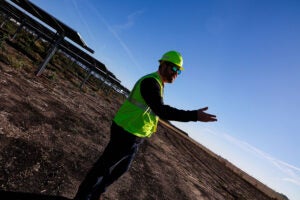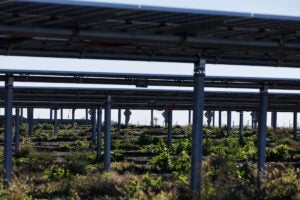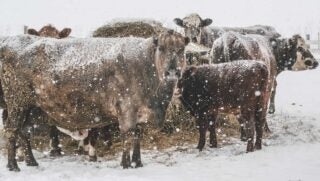AMES, Iowa — On a chilly fall morning, the Alliant Energy Solar Farm at Iowa State University looked like any other solar farm. Thousands of panels stretched toward the heavens and fanned across the landscape, welcoming any rays of sun that might escape the overcast sky above.
But it’s not your typical solar array.
Come next year, the ground underneath and around the panels will bloom with fruits, vegetables and pollinator plants. The practice is called agrivoltaics: where active farming or ranching and solar happen in the same place instead of separately.
It puts the “farm” in solar farm.
The Alliant Energy Solar Farm at ISU, unveiled in October in Ames, marks the first utility-scale agrivoltaics project in Iowa and the Midwest at large.
The 10-acre solar farm has a maximum energy output of 1.35 megawatts — enough to power around 200 homes at full capacity. As Alliant’s panels transform sunlight into electricity, ISU researchers will grow and harvest crops underneath.
It took millions of dollars and dozens of experts to make the project a reality. Collaborations span several industries, from energy production to horticulture to entomology. The site will be home to a treasure trove of research that, researchers hope, can show if agriculture and solar energy can coexist in Iowa and beyond.
“There are a lot of communities who are thinking about community solar arrays,” said Anne Kimber, director of ISU’s Electric Power Research Center. “Well, imagine if the community also gets to have gardens associated with those arrays. You’re starting to build community around that. I think that’s worth working on.”
How it came to be
The project has been in the works for years — but it was first conceptualized as just a solar project, a partnership announced in fall 2021. The plan shifted when an agrivoltaics grant opportunity from the U.S. Department of Energy opened up.
Both ISU and Alliant serve rural residents across the state, said Nick Peterson, Alliant’s strategic partnerships manager. Integrating agriculture into the project could better serve their customers and missions. It could also provide a first-of-its-kind research opportunity in Iowa. And, thanks to the diverse skill sets across both institutions, they had the capacity to dive into this emerging practice.
So, they shifted their plans and applied. The project received a $1.8 million four-year grant from the U.S. Department of Energy — the largest allotment awarded from the funding program.
Alliant and ISU worked together to design the research project. Solar panel heights vary between 5 feet — the industry standard — and 8 feet. Those differences change how much light will reach the plants grown underneath. That will alter the microclimates under the panels, influencing factors like humidity and temperature.

The panels themselves differ as well. Some are in fixed positions, meaning their angle doesn’t change. Others rotate to track the sun across the sky. All of them are bifacial, meaning they can harvest solar energy on both sides.
Then came the horticultural decisions: What should be planted underneath?
Researchers considered high-value and popular crops that could fit under solar panels. They chose broccoli, summer squash and peppers for vegetables. For fruits, they landed on strawberries and raspberries. The harvested crops will go to the ISU Horticulture Research Station, where they will be cleaned, packaged and sold to the university’s dining halls.
Three of the five crops require bee pollination to grow. To ensure the survival of the plants, the team is adding pollinator plant mixes to the site and raising honeybees. Entomologists also track how the bees interact with the on-site foraging habitat. They’ll also harvest honey produced in the on-site bee boxes that house the colonies.
“If we don’t keep honeybees at the site, we can’t guarantee that bees will be there to pollinate the plants,” said Matt O’Neal, an ISU professor in plant pathology, entomology and microbiology. “As we produce the vegetation and we allow it to grow, we hope to see how this site could be improved and eventually become the kind of place that beekeepers would want to keep their hives.”
The facility marks Alliant’s first customer-hosted solar project to complete construction in Iowa. It will cost the utility $4.2 million — much of which was gleaned from existing customer rates, Peterson said.
The extra money needed to transform it into an agrivoltaics project came from investors, not Alliant customers. The utility owns and operates the facility and leases the land from ISU.
All $1.8 million from the U.S. Department of Energy will support ISU’s research on the site. The funding will support farming costs, labor costs, outreach and education, and more.
“It’s a win-win for both entities,” Peterson said. “This is a big deal for us that we’re getting this done.”
Research in action
The site wrapped on construction this month. The first batch of plants — raspberries — will be planted within the next month and go dormant in the winter. The panels will be fully operational in early 2024. Come spring, the grounds should be teeming with budding crops.
The U.S. Department of Energy funding should support ISU’s research through three growing seasons. Over those years, researchers will be analyzing every aspect of the crops and the solar production.
One variable they’re looking at is crop yield: Will the shade from the panels reduce or increase the yields of the fruits and veggies planted underneath? Will there be more or less disease or pests? Will harvest periods change?
ISU graduate students, undergraduate students and technicians will manage the crops and track their growth. Sensors will collect data on the environmental conditions beneath the panels. This data will be compared to on-site crops grown in direct sunlight without any panels overhead — the control group.

Teams also will be keeping an eye on energy production. The vegetation underneath the panels may cool the technology, helping it produce energy more efficiently.
Researchers will track the costs and revenues associated with growing food and beekeeping within an agrivoltaics system. Those budgets can help guide decisions for farmers and solar developers who may try their hand at agrivoltaics.
Underrepresented farming groups, like refugee and Indigenous communities, also will have the opportunity to grow crops in the space around the arrays.
“Land costs and implement costs are some of the biggest barriers to entry into the ag industry,” Peterson said. “This (project) could offer opportunities to break down barriers to access for people who want to get into the ag industry.”
Bridging the divide
You likely see parts of the energy grid everyday, like power lines and transmission lines. As renewable energy grows more popular, it places more energy generation — like wind turbines and solar arrays — closer to communities. Nearby residents aren’t always happy about that.
The energy world has to figure out how to make green energy projects more attractive to communities. Agrivoltaics could be the way to go, those in the industry think.
As the project commences, researchers will be surveying a variety of stakeholders about the concept of agrivoltaics, from beginning farmers to refugee farmers. They hope to uncover the factors that drive perceptions about solar — like costs and land use, for example.
“At this stage, solar can stand on its own to actually be a viable, (economically competitive) part of our energy supply,” said Hongli Feng, an ISU assistant professor of economics. “The thing is, will it actually be implemented?”
Team members contributing to the Alliant Energy Solar Farm at Iowa State University see the project as an opportunity to better educate the public about solar energy and the feasibility of agrivoltaics. Producers, policymakers, solar developers and the public at large will be invited to visit the site on field days to see the process for themselves.
“A big test area for this grant is also the demonstration and extension outreach aspects, where we want the growers to come check out the plots, evaluate the crops and ask themselves, ‘What’s the feasibility of such a system?’” said Ajay Nair, an ISU associate professor of horticulture. “This is unbiased research. We will report what we find, and people can decide whether this is a system that is feasible or not.”
Brittney J. Miller is the Energy and Environment Reporter for The Gazette and a corps member with Report for America, a national service program that places journalists in local newsrooms to report on under-covered issues.
This story is a product of The Cedar Rapids Gazette and distributed through the Mississippi River Basin Ag & Water Desk. News outlets can sign up to republish stories like this one for free.


